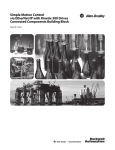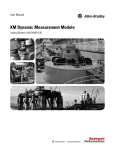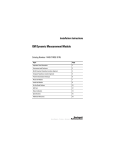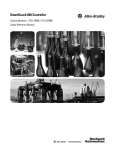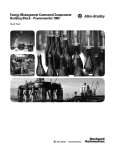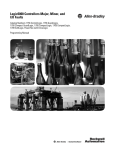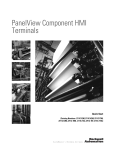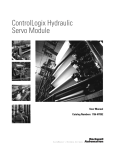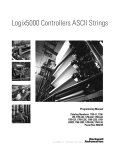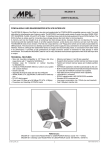Download XM ControlNet Adapter User Manual
Transcript
User Manual XM ControlNet Adapter Catalog Number 1440-ACNR Important User Information Solid state equipment has operational characteristics differing from those of electromechanical equipment. Safety Guidelines for the Application, Installation and Maintenance of Solid State Controls (publication SGI-1.1 available from your local Rockwell Automation sales office or online at http://www.rockwellautomation.com/literature) describes some important differences between solid state equipment and hard-wired electromechanical devices. Because of this difference, and also because of the wide variety of uses for solid state equipment, all persons responsible for applying this equipment must satisfy themselves that each intended application of this equipment is acceptable. In no event will Rockwell Automation, Inc. be responsible or liable for indirect or consequential damages resulting from the use or application of this equipment. The examples and diagrams in this manual are included solely for illustrative purposes. Because of the many variables and requirements associated with any particular installation, Rockwell Automation, Inc. cannot assume responsibility or liability for actual use based on the examples and diagrams. No patent liability is assumed by Rockwell Automation, Inc. with respect to use of information, circuits, equipment, or software described in this manual. Reproduction of the contents of this manual, in whole or in part, without written permission of Rockwell Automation, Inc., is prohibited. Throughout this manual, when necessary, we use notes to make you aware of safety considerations. WARNING IMPORTANT ATTENTION Identifies information about practices or circumstances that can cause an explosion in a hazardous environment, which may lead to personal injury or death, property damage, or economic loss. Identifies information that is critical for successful application and understanding of the product. Identifies information about practices or circumstances that can lead to personal injury or death, property damage, or economic loss. Attentions help you identify a hazard, avoid a hazard, and recognize the consequence SHOCK HAZARD Labels may be on or inside the equipment, for example, a drive or motor, to alert people that dangerous voltage may be present. BURN HAZARD Labels may be on or inside the equipment, for example, a drive or motor, to alert people that surfaces may reach dangerous temperatures. Allen-Bradley, Rockwell Software, Rockwell Automation, XM, ControlLogix, Logix5000, RSLogix, RSNetWorx, and TechConnect are trademarks of Rockwell Automation, Inc. Trademarks not belonging to Rockwell Automation are property of their respective companies. 2 Rockwell Automation Publication ICM-UM001C-EN-E - March 2013 Table of Contents Preface What This Preface Contains . . . . . . . . . . . . . . . . . . . . . . . . . . . . . . . . . . 5 Who Should Use This Manual. . . . . . . . . . . . . . . . . . . . . . . . . . . . . . . . . 5 Common Techniques Used in This Manual . . . . . . . . . . . . . . . . . . . . . . 5 Additional Resources . . . . . . . . . . . . . . . . . . . . . . . . . . . . . . . . . . . . . . . . 5 Chapter 1 Introduction About the Module . . . . . . . . . . . . . . . . . . . . . . . . . . . . . . . . . . . . . . . . . . 7 Hardware Components . . . . . . . . . . . . . . . . . . . . . . . . . . . . . . . . . . . . . . 8 Chapter 2 Install the Adapter North American Hazardous Location Approval . . . . . . . . . . . . . . 11 European Hazardous Location Approval. . . . . . . . . . . . . . . . . . . . 12 Power Requirements . . . . . . . . . . . . . . . . . . . . . . . . . . . . . . . . . . . . . . . 13 Terminating Resistors . . . . . . . . . . . . . . . . . . . . . . . . . . . . . . . . . . . . . . 13 Install the Adapter . . . . . . . . . . . . . . . . . . . . . . . . . . . . . . . . . . . . . . . . . 14 Panel/Wall Mounting . . . . . . . . . . . . . . . . . . . . . . . . . . . . . . . . . . . 15 Set the Node Address . . . . . . . . . . . . . . . . . . . . . . . . . . . . . . . . . . . . . . 15 Wire the Adapter . . . . . . . . . . . . . . . . . . . . . . . . . . . . . . . . . . . . . . . . . . 15 Connect Programming Terminal to the Network . . . . . . . . . . . . . . . . 17 Install the XM Modules . . . . . . . . . . . . . . . . . . . . . . . . . . . . . . . . . . . . . 18 Replace an Adapter . . . . . . . . . . . . . . . . . . . . . . . . . . . . . . . . . . . . . . . . 18 Remove Existing Adapter . . . . . . . . . . . . . . . . . . . . . . . . . . . . . . . . 19 Install Replacement Adapter . . . . . . . . . . . . . . . . . . . . . . . . . . . . . . 19 Chapter 3 Configure the Adapter 3Publication ICM-UM001C-EN-E - March 2013 Use the Help Button . . . . . . . . . . . . . . . . . . . . . . . . . . . . . . . . . . . . . . . 21 Set Up Your Computer to Connect to a ControlNet Network . . . . . . 21 Add Modules to the I/O Configuration . . . . . . . . . . . . . . . . . . . . . . . . 22 Select a Controller . . . . . . . . . . . . . . . . . . . . . . . . . . . . . . . . . . . . . . 22 Select a ControlNet Bridge . . . . . . . . . . . . . . . . . . . . . . . . . . . . . . . 23 Add the 1440-ACNR Adapter . . . . . . . . . . . . . . . . . . . . . . . . . . . . 26 Add XM Modules . . . . . . . . . . . . . . . . . . . . . . . . . . . . . . . . . . . . . . 29 Download the Program to the Controller. . . . . . . . . . . . . . . . . . . . . . . 32 Schedule the I/O Module Connections . . . . . . . . . . . . . . . . . . . . . . . . 33 Schedule the Network Online . . . . . . . . . . . . . . . . . . . . . . . . . . . . . 34 Reschedule a ControlNet Network That Has Previously Been Scheduled . . . . . . . . . . . . . . . . . . . . . . . . . . . . . . . . . . . . . . . . . . . . . 37 Access Module Data using the ACNR . . . . . . . . . . . . . . . . . . . . . . . . . 39 3 Table of Contents Chapter 4 Troubleshoot the Module Status Indicators . . . . . . . . . . . . . . . . . . . . . . . . . . . . . . . . . . . . . . . . . . . 41 Module Status Indicator . . . . . . . . . . . . . . . . . . . . . . . . . . . . . . . . . 42 ControlNet A and ControlNet B Status Indicators Together . . . . 42 ControlNet A or ControlNet B Status Indicator Individually . . . 42 Backplane Status Indicator . . . . . . . . . . . . . . . . . . . . . . . . . . . . . . . 43 Index . . . . . . . . . . . . . . . . . . . . . . . . . . . . . . . . . . . . . . . . . . . . . . . . . . . . . . . . . 45 4 Publication ICM-UM001C-EN-E - March 2013 Preface What This Preface Contains This preface describes how to use this manual. Who Should Use This Manual This manual introduces you to the XM® ControlNet Adapter. It is intended for anyone who installs, configures, or uses the XM ControlNet Adapter module. Common Techniques Used in This Manual There are several document conventions used in this manual, including the following: TIP EXAMPLE 5Publication ICM-UM001C-EN-E - March 2013 A tip indicates additional information which may be helpful. This convention presents an example. 5 Preface Additional Resources These documents contain additional information concerning related products from Rockwell Automation. Resource Description XM Monitoring Modules Specifications Provides specifications for the 1440 series of Technical Data, publication 1440-TD001. Rockwell Automation monitoring modules. XM ControlNet Adapter Installation Instructions, publication ICM-IN001. Provides information about installing the adapter module and technical specifications. Dynamic Measurement Module Installation Instructions, publication ICM-IN002 Provides information about mounting the Dynamic Measurement module and technical specifications. Dynamic Measurement Terminal Base Installation Instructions, publication ICM-IN003 Provides information about installing the terminal base for the Dynamic Measurement module, and technical specifications. Dynamic Measurement Module User Manual, publication ICM-UM002 Provides details about how to install, wire and use the Dynamic Measurement module. Industrial Automation Wiring and Grounding Guidelines, publication 1770-4.1 Provides general guidelines for installing a Rockwell Automation industrial system. ControlLogix System User Manual, publication 1756-UM001 Describes how to use ControlNet with a controller. ControlNet Modules in Logix5000 Systems User Manual, publication CNET-UM001 Provides information on how to connect a computer to a ControlNet network Product Certifications website, http://ab.com Provides declarations of conformity, certificates, and other certification details. You can view or download publications at http://www.rockwellautomation.com/literature. To order paper copies of technical documentation, contact your local Allen-Bradley distributor or Rockwell Automation sales representative. 6 Publication ICM-UM001C-EN-E - March 2013 Chapter 1 Introduction This chapter describes the XM ControlNet Adapter (Catalog Number 1440-ACNR). About the Module Topic Page About the Module 7 Hardware Components 8 The 1440-ACNR module operates as a communication adapter for the 1440-DYN02-01RJ module. It provides an interface for controlling this module on an XM Bus and transferring data to the processor over a ControlNet network. The ControlNet network is a communication architecture that enables the exchange of messages between ControlNet products compliant with the ControlNet International specification. It provides high-speed transport of time-critical I/O and interlocking data and messaging data, including upload/download of programming and configuration data on a single physical media link. The module supports: • Control of I/O on the XM Bus, with up to 10 XM Dynamic Measurement modules (Cat. No. 1440-DYN02-01RJ) connected to the adapter. • Unscheduled messaging data for configuration and retrieval of data. • Local communication network access through the network access port (NAP). 7Publication ICM-UM001C-EN-E - March 2013 7 Chapter 1 Introduction Hardware Components The 1440-ACNR consists of the following hardware components. 9 1 XM® Cont rolNet XM Adapte 1440-ACNR r 2 MS CHA CHB BPS 8 3A 7 3B 4 5 6 31770-M 8 Item Component Description 1 ControlNet Adapter Module 2 Status Indicators Four LEDs that indicate the status of the adapter, backplane, and the network. 3A Channel A Coax Receptacle Channel A BNC connection. 3B Channel B Coax Receptacle Channel B BNC connection. 4 Module Locking tab 5 ControlNet Node Address Switches Pushwheel switches for setting the node address. Refer to Set the Node Address on page 15. 6 Network Access Port (NAP) Provides a bidirectional electrical interface for programming, maintenance, and I/O monitoring devices. Refer to the ControlNet Coax Media Planning and Installation Guide, publication CNET-IN002. 7 24V DC Connections +V DC power connections. 8 24V Common Connections -V common connections. 9 XM Bus Connector Connects the adapter to the XM modules on the XM Bus. Publication ICM-UM001C-EN-E - March 2013 Chapter 2 Install the Adapter This chapter describes the procedures for installing the adapter. 9Publication ICM-UM001C-EN-E - March 2013 Topic Page Power Requirements 13 Terminating Resistors 13 Install the Adapter 14 Set the Node Address 15 Wire the Adapter 15 Connect Programming Terminal to the Network 17 Install the XM Modules 18 Replace an Adapter 18 9 Chapter 2 Install the Adapter ATTENTION Environment and Enclosure This equipment is intended for use in a Pollution Degree 2 industrial environment, in overvoltage Category II applications (as defined in IEC 60664-1), at altitudes up to 2000 m (6562 ft) without derating. This equipment is not intended for use in residential environments and may not provide adequate protection to radio communication services in such environments. This equipment is supplied as open-type equipment. It must be mounted within an enclosure that is suitably designed for those specific environmental conditions that will be present and appropriately designed to prevent personal injury resulting from accessibility to live parts. The enclosure must have suitable flame-retardant properties to prevent or minimize the spread of flame, complying with a flame spread rating of 5VA or be approved for the application if nonmetallic. The interior of the enclosure must be accessible only by the use of a tool. Subsequent sections of this publication may contain additional information regarding specific enclosure type ratings that are required to comply with certain product safety certifications. In addition to this publication, see the following: • Industrial Automation Wiring and Grounding Guidelines, publication 1770-4.1, for additional installation requirements. • NEMA Standard 250 and IEC 60529, as applicable, for explanations of the degrees of protection provided by enclosures. ATTENTION Prevent Electrostatic Discharge This equipment is sensitive to electrostatic discharge, which can cause internal damage and affect normal operation. Follow these guidelines when you handle this equipment: • • • • • • 10 Touch a grounded object to discharge potential static. Wear an approved grounding wrist strap. Do not touch connectors or pins on component boards. Do not touch circuit components inside the equipment. Use a static-safe workstation, if available. Store the equipment in appropriate static-safe packaging when not in use. Publication ICM-UM001C-EN-E - March 2013 Install the Adapter Chapter 2 North American Hazardous Location Approval The following information applies when operating this equipment in hazardous locations. Products marked "CL I, DIV 2, GP A, B, C, D" are suitable for use in Class I Division 2 Groups A, B, C, D, Hazardous Locations and nonhazardous locations only. Each product is supplied with markings on the rating nameplate indicating the hazardous location temperature code. When combining products within a system, the most adverse temperature code (lowest "T" number) may be used to help determine the overall temperature code of the system. Combinations of equipment in your system are subject to investigation by the local Authority Having Jurisdiction at the time of installation. WARNING Explosion Hazard Informations sur l’utilisation de cet équipement en environnements dangereux. Les produits marqués "CL I, DIV 2, GP A, B, C, D" ne conviennent qu'à une utilisation en environnements de Classe I Division 2 Groupes A, B, C, D dangereux et non dangereux. Chaque produit est livré avec des marquages sur sa plaque d'identification qui indiquent le code de température pour les environnements dangereux. Lorsque plusieurs produits sont combinés dans un système, le code de température le plus défavorable (code de température le plus faible) peut être utilisé pour déterminer le code de température global du système. Les combinaisons d'équipements dans le système sont sujettes à inspection par les autorités locales qualifiées au moment de l'installation. Risque d’Explosion WARNING • Do not disconnect equipment unless power has been removed or the area is known to be nonhazardous. • Couper le courant ou s'assurer que l'environnement est classé non dangereux avant de débrancher l'équipement. • Secure any external connections that mate to this equipment by using screws, sliding latches, threaded connectors, or other means provided with this product. • Couper le courant ou s'assurer que l'environnement est classé non dangereux avant de débrancher les connecteurs. Fixer tous les connecteurs externes reliés à cet équipement à l'aide de vis, loquets coulissants, connecteurs filetés ou autres moyens fournis avec ce produit. • Substitution of components may impair suitability for Class I, Division 2. • If this product contains batteries, they must only be changed in an area known to be nonhazardous. • La substitution de composants peut rendre cet équipement inadapté à une utilisation en environnement de Classe I, Division 2. • S'assurer que l'environnement est classé non dangereux avant de changer les piles. Publication ICM-UM001C-EN-E - March 2013 11 Chapter 2 Install the Adapter European Hazardous Location Approval The following applies when the product bears the Ex Marking. This equipment is intended for use in potentially explosive atmospheres as defined by European Union Directive 94/9/EC and has been found to comply with the Essential Health and Safety Requirements relating to the design and construction of Category 3 equipment intended for use in Zone 2 potentially explosive atmospheres, given in Annex II to this Directive. Compliance with the Essential Health and Safety Requirements has been assured by compliance with EN 60079-15 and EN 60079-0. ATTENTION WARNING This equipment is not resistant to sunlight or other sources of UV radiation. • This equipment must be installed in an enclosure providing at least IP54 protection when applied in Zone 2 environments. • This equipment must be used within its specified ratings defined by Rockwell Automation. • Provision must be made to prevent the rated voltage from being exceeded by transient disturbances of more than 140% of the rated voltage when applied in Zone 2 environments. • This equipment must be used only with ATEX certified backplanes. • Secure any external connections that mate to this equipment by using screws, sliding latches, threaded connectors, or other means provided with this product. • Do not disconnect equipment unless power has been removed or the area is known to be nonhazardous. • This equipment must be mounted in an ATEX certified enclosure with a minimum ingress protection rating of at least IP54 (as defined in IEC60529) and used in an environment of not more than Pollution Degree 2 (as defined in IEC 60664-1) when applied in Zone 2 environments. The enclosure must utilize a tool removable cover or door. 12 Publication ICM-UM001C-EN-E - March 2013 Install the Adapter Chapter 2 The ControlNet adapter module requires a single Class 2 power supply. Before installing your module, calculate the power requirements of all modules in each chassis. The total current draw through the side connector cannot exceed 3 A. Power Requirements The adapter provides a maximum output current of 3A. ATTENTION Multiple power sources are not allowed. The XM Bus will operate correctly when there is a terminating resistor at each end of the XM Bus. Terminating Resistors • Terminating resistors must be 121 ohms, 1%, 1/4 W. • The ControlNet adapter has an internal terminating resistor. Install a second terminating resistor across the CAN_HI and CAN_LO terminals of the XM module at the other end of the XM Bus. For information on the XM module, refer to the Dynamic Measurement Module User Manual, publication ICM-UM002. XM® 1 1 1 Class 2 XM BUS COMMON CAN LOW DRAIN WIRE CAN HIGH 24 V Supply 24 V COM XM® 1 1 1 1 24 V 24 V COM Publication ICM-UM001C-EN-E - March 2013 Termination resistor 121 ohm, 1%, 1/4W 31865 13 Chapter 2 Install the Adapter Install the Adapter To install the adapter on the DIN rail prior to installing other XM terminal base units, follow these steps. This product is grounded through the DIN rail to chassis ground. Use zinc plated yellow-chromate steel DIN rail to assure proper grounding. The use of other DIN rail materials (for example, aluminum or plastic) that can corrode, oxidize, or are poor conductors, can result in improper or intermittent grounding. Secure DIN rail to mounting surface approximately every 200 mm (7.8 in.) and use end-anchors appropriately. ATTENTION The 1440-DYN02-01RJ Dynamic Measurement module is used with the 1440-ACNR. Any other XM catalog number will not work with the 1440-ACNR. IMPORTANT The XM Bus must be terminated on each end with a 121 ohm, 1%, 1/4 W resistor. Because the adapter has an internal terminator resistor, the second resistor must be connected to the I/O module at the opposite end of the XM Bus. IMPORTANT 1. Position the ControlNet adapter module (A) on a 35 x 7.5 mm DIN rail (B) at a slight angle. A XM® B Cont rolNet XM Adapter 1440-ACNR Cont r olNet XM Adapter XM® 1440-ACNR MS MS CHA CHB CHA CHB BPS BPS C 31769-M 2. Hook the lip on the rear of the adapter onto the top of the DIN rail, and rotate the adapter module onto the rail. 3. Press the adapter module down onto the DIN rail until flush. Locking tab C will snap into position and lock the adapter module to the DIN rail. 4. If the adapter module does not lock in place, use a screwdriver or similar device to move the locking tab down while pressing the adapter module flush onto the DIN rail, and release the locking tab to lock the adapter module in place. If necessary, push up on the locking tab to lock. 5. Connect the adapter wiring. Refer to Wire the Adapter on page 15. 14 Publication ICM-UM001C-EN-E - March 2013 Install the Adapter Chapter 2 Panel/Wall Mounting If mounting the adapter to a panel or wall, refer to publication 1794-5.13, "Panel Mounting Kit, Cat. No. 1794-NM1." Set the Node Address Set the node address using the 2-position pushwheel switch. Valid settings range from 01 to 99. Press either the + or - buttons to change the number. 2 5 Network Address Switch Wire the Adapter Follow these steps to wire the adapter. ATTENTION WARNING Publication ICM-UM001C-EN-E - March 2013 Do not wire more than two conductors on any single terminal. If you connect or disconnect wiring while the field-side power is on, an electrical arc can occur. This could cause an explosion in hazardous location installations. Be sure that power is removed or the area is nonhazardous before proceeding. 15 Chapter 2 Install the Adapter If you connect or disconnect the communications cable with power applied to this module or any device on the network, an electrical arc can occur. This could cause an explosion in hazardous location installations. WARNING Be sure that power is removed or the area is nonhazardous before proceeding. C E 1440-ACNR ControlNet XM Adapter 2 5 A A B B G D F 1. Connect the ControlNet network cable to connector A. 2. Connect the redundant ControlNet network cable to connector B. ATTENTION When connecting wiring, torque terminal screws C, D, E, and F to 0.8 Nm (7 lb-in). 3. Connect +V DC power to the lower connector, terminal F or D. 4. Connect -V common to the upper connector, terminal E or C. 16 Publication ICM-UM001C-EN-E - March 2013 Install the Adapter Connect Programming Terminal to the Network Chapter 2 You can connect the programming terminal to the ControlNet network by connecting to the network access port (NAP), as shown in the figure. 1440-ACNR XM® 1440-ACNR Cont r olNet XM Adapter 1784-PCC Programming Terminal 1786-CP MS CHA CHB BPS Network Access Port (NAP) The 1786-CP cable can be plugged into any ControlNet product’s NAP to provide programming capability on the ControlNet network. A programming terminal connected through this cable is counted as a node and must have a unique address. ATTENTION WARNING Use the 1786-CP cable when connecting a programming terminal to the network through NAPs. Using a commercially available RJ-style cable could result in possible network failures. The NAP port is intended for temporary local programming purposes only and not intended for permanent connection. If you connect or disconnect the NAP cable with power applied to this module or any device on the network, an electrical arc can occur. This could cause an explosion in hazardous location installations. Be sure that power is removed or the area is nonhazardous before proceeding. Publication ICM-UM001C-EN-E - March 2013 17 Chapter 2 Install the Adapter Install the XM Modules After installing and wiring the adapter, install the XM modules used for your application. IMPORTANT The 1440-DYN02-01RJ Dynamic Measurement module works with the 1440-ACNR. Any other XM catalog number will not work with the 1440-ACNR. For information on installing and wiring the XM modules, refer to the following documentation. • Installation instructions for the Dynamic Measurement module, publication ICM-IN002. • Installation instructions for the Dynamic Measurement terminal base, publication ICM-IN003. • User manual for the Dynamic Measurement module, publication ICM-UM002. Replace an Adapter Follow these steps to install a replacement adapter to an existing system. ATTENTION If you insert or remove the module while backplane power is on, an electrical arc can occur. This could cause an explosion in hazardous location installations. Be sure that power is removed or the area is nonhazardous before proceeding. ATTENTION WARNING 18 Do not remove or replace an Adapter Module while power is applied. Interruption of the backplane can result in unintentional operation or machine motion. If you connect or disconnect wiring while the field-side power is on, an electrical arc can occur. This could cause an explosion in hazardous location installations. Be sure that power is removed or the area is nonhazardous before proceeding. Publication ICM-UM001C-EN-E - March 2013 Install the Adapter WARNING Chapter 2 If you connect or disconnect the communications cable with power applied to this module or any device on the network, an electrical arc can occur. This could cause an explosion in hazardous location installations. Be sure that power is removed or the area is nonhazardous before proceeding. Remove Existing Adapter Remove the existing adapter from the DIN rail as follows. 1. Disconnect any wiring jumpered to the adjacent terminal base. 2. Disconnect the BNC connector(s) from the front of the adapter. 3. On the XM module adjacent to the adapter, open the latching mechanism and remove the module from the terminal base unit that is attached to the adapter. 4. Push the XM Bus connector toward the right side of the terminal base to unplug the backplane connection. 5. Release the locking tab and remove the adapter module. Install Replacement Adapter Install the replacement adapter on the DIN rail as follows. 1. Before installing the replacement adapter, make certain the XM Bus connector of the XM terminal base is fully retracted into the base unit. 2. Position the replacement adapter on the DIN rail. The hook on the terminal base slides under the edge of the adapter. 3. Push down and in at the same time to lock the adapter to the DIN rail. If the adapter does not lock in place, use a screwdriver or similar device to move the locking tab down while pressing the adapter flush onto the DIN rail, and release the locking tab to lock the adapter module in place. Publication ICM-UM001C-EN-E - March 2013 19 Chapter 2 Install the Adapter 4. Gently push the XM Bus connector into the side of the adapter to complete the backplane. Cont rolNet XM Adapter MS CHA CHB XM® 1440-ACNR BPS 31768-M 5. Reinstall the XM module in the adjacent terminal base. 6. Connect the wiring to the adjacent terminal base. 7. Connect the ControlNet cable to the adapter. 20 Publication ICM-UM001C-EN-E - March 2013 Chapter 3 Configure the Adapter This chapter provides the steps required to configure the XM ControlNet Adapter using ControlLogix®. Topic Page Use the Help Button 21 Set Up Your Computer to Connect to a ControlNet Network 21 Add Modules to the I/O Configuration 22 Download the Program to the Controller 32 Schedule the I/O Module Connections 33 Access Module Data using the ACNR 39 Use the Help Button Click Help at the bottom of the dialog box to get information about the entries in the dialog boxes. Click Help in a warning dialog box to get information about the specific error. Set Up Your Computer to Connect to a ControlNet Network You connect your personal computer to a ControlNet network via an RSLinx ControlNet software communication driver. You use the ControlNet communication driver to: • upload and download controller projects using RSLogix™ 5000 programming software. • schedule a ControlNet network via RSNetWorx for ControlNet software. For more information on how to connect a computer to a ControlNet network, refer to the ControlNet Modules in Logix5000™ Systems User Manual, publication CNET-UM001. 21Publication ICM-UM001C-EN-E - March 2013 21 Chapter 3 Configure the Adapter Add Modules to the I/O Configuration To establish communication between the controller and adapter over the network, you must add the ControlLogix controller and its bridge to the I/O Configuration. Select a Controller 1. Start RSLinx software. 2. Start RSLogix 5000 Enterprise series software, version 16 or later. 3. From the File menu, choose New. The New Controller dialog box opens. 22 Publication ICM-UM001C-EN-E - March 2013 Configure the Adapter Chapter 3 4. Complete the following entries. In this field Enter Type Choose the controller type. Revision Choose the major revision of the firmware for which the project is configured. Name Enter a unique name for the controller. Chassis Type Choose the appropriate chassis type. Slot Enter the slot of the controller in the chassis. Create In Enter the directory in which you want to store the project file. 5. Verify that the revision of the controller is compatible with the XM products. The controller’s revision should be 16 or later. 6. Click OK to create the project. The following screen appears. Select a ControlNet Bridge You need a ControlNet bridge to access the 1440-ACNR adapter from the ControlLogix network. In our example, we will configure a 1756-CNB (Series D) bridge to communicate with 1440-ACNR adapter. 1. In the Controller Organizer, right-click the I/O Configuration folder and select New Module. Publication ICM-UM001C-EN-E - March 2013 23 Chapter 3 Configure the Adapter The Select Module dialog box opens. 2. Click the plus sign next to the Communications folder to display a list of available communication modules. 3. Select the ControlNet Bridge and click OK. In this example, we use a 1756-CNB ControlNet Bridge (Series D). The Select Major Revision dialog box opens. 4. Select the number for the Major Revision, and click OK. 24 Publication ICM-UM001C-EN-E - March 2013 Configure the Adapter Chapter 3 The New Module dialog box opens. 5. Enter the following information. On this tab In this field Enter General Name Enter a unique name for the module. Node Address Enter the node address of the module. Slot Enter the slot of the bridge in the rack. Revision Select the major and minor revision level. Electronic Keying Choose the appropriate electronic keying method. 6. The Module Properties dialog box opens when Open Module Properties is checked. Clear the Open Module Properties check box if you do not need to further configure the module. 7. Click OK to accept the configuration. The ControlNet Bridge is added to the I/O Configuration. Publication ICM-UM001C-EN-E - March 2013 25 Chapter 3 Configure the Adapter Add the 1440-ACNR Adapter The 1440-ACNR adapter is added as a child of the local 1756-CNB/D module. 1. Under the I/O Configuration folder, right-click the ControlNet icon and select New Module. The Select Module dialog box opens. 26 Publication ICM-UM001C-EN-E - March 2013 Configure the Adapter Chapter 3 2. Click the plus sign next to the Communications folder to display a list of available communication modules. 3. Select the 1440-ACNR/A ControlNet adapter and click OK. The New Module dialog box opens. 4. Enter the following information. On this tab In this field Enter General Name Enter a unique name for the adapter. Controller Node Enter the node address of the adapter. Comm Format The Comm Format for the 1440-ACNR is None. The adapter makes a direct connection to the XM module referenced by the data. Revision Select the major and minor revision level. Electronic Keying Choose the appropriate electronic keying method. 5. Click OK to accept the configuration. Publication ICM-UM001C-EN-E - March 2013 27 Chapter 3 Configure the Adapter The Module Properties dialog box opens if you checked Open Module Properties TIP The requested packet interval (RPI) is disabled when the Comm Format is None. 6. From the Connection tab, enter the following information. On this tab In this field Enter Connection Inhibit Module Check to disable communication between the controller and the module. Clear to restore communications. Major Fault on Controller if Connection Fails While in Run Mode Check to have the controller to produce a major fault if the connection fails in Run mode. Clear if you do not want the controller to produce a major fault. Module Fault Displays the fault code returned from the controller and the text detailing the Module Fault. 7. Click OK to close the dialog box. The 1440-ACNR adapter is added to the I/O Configuration. 28 Publication ICM-UM001C-EN-E - March 2013 Configure the Adapter Chapter 3 Add XM Modules Select Speciality in the Select Module dialog box to add the XM Dynamic Measurement module. 1. Under the I/O Configuration folder, right-click the XM icon and select New Module. The Select Module dialog box opens. Publication ICM-UM001C-EN-E - March 2013 29 Chapter 3 Configure the Adapter 2. Click the plus sign next to the Specialty folder to display a list of XM modules. 3. Select the 1440-DYN02-01RJ module and click OK. TIP If you do not see the module in the list, you may need to obtain the AOP from the Rockwell Automation support website. 1. Go to http://www.rockwellautomation.com/support/. 2. Click Downloads/RSLogix 5000 I/O Modules Add-on Profiles. 3. Select the 1440-DYN02-01RJ XM Dynamic Vibration Measurement Module Add-on Profile. 30 Publication ICM-UM001C-EN-E - March 2013 Configure the Adapter Chapter 3 The New Module dialog box opens. 4. From the General tab, enter the following information. On this tab In this field Enter General Name Enter a unique name for the module. Node Address Enter the node address of the module. This number and the dip switches on the module must match. DIP switches 5 through 10 set the module’s node address using binary addressing. We recommend that you set the node address to the position of the module. For example, the module next to the adapter is node address 1. If there are two module between this module and the adapter, the node address is 3. Refer to the XM Dynamic Measurement Module User Manual, publication ICM-UM002, for more information about the dip switches. 5. Click OK to close the dialog box. Publication ICM-UM001C-EN-E - March 2013 31 Chapter 3 Configure the Adapter The 1440-DYN02-01RJ module is added to the I/O Configuration. Refer to the XM Dynamic Measurement Module User Manual, publication ICM-UM002, or online help for information on configuring the module. Download the Program to the Controller After adding the adapter and the XM module to the I/O configuration, you must download the configuration to the controller. You should also save the configuration to a file on your computer. 1. From the Communications menu, choose Who Active. The Who Active dialog box opens. 2. Select the controller to which you need to download a project and click Set Project Path to establish the path. 3. Click Download to download the configuration to the controller. 32 Publication ICM-UM001C-EN-E - March 2013 Configure the Adapter Chapter 3 The Download dialog box opens. 4. Click Download. When the download is successfully completed, RSLogix 5000 goes into the Online mode and the I/O Not Responding box in the upper-left of the window should be flashing green. Also a yellow warning symbol should be displayed on the I/O Configuration folder in the I/O tree and on the 1440-DYN02-01RJ module. This is because the connections have not yet been scheduled using RSNetWorx™ for ControlNet software. 5. From the File menu, choose Save to save the project. To ensure that the present project configuration values are saved, RSLogix 5000 prompts you to upload them. Click Yes to upload and save configuration values. Schedule the I/O Module Connections You must use RSNetWorx for ControlNet software to schedule the network in order to activate the configured XM module. Publication ICM-UM001C-EN-E - March 2013 33 Chapter 3 Configure the Adapter Schedule the Network Online If your network has already been scheduled and you made a change to it, you must reschedule it. Refer to Reschedule a ControlNet Network That Has Previously Been Scheduled on page 37. 1. Start RSNetWorx for ControlNet software. 2. From the File menu, choose New. The New File dialog box opens. 3. Choose ControlNet Configuration and click OK. 4. From the Network menu, choose Online The Browse for Network dialog box opens. 5. Expand the tree to find and choose the communication path to the ControlNet network. 34 Publication ICM-UM001C-EN-E - March 2013 Configure the Adapter Chapter 3 6. Click OK. 7. As the selected ControlNet path is browsed, RSNetWorx for ControlNet software creates a graphical representation of the devices on the network. 8. Click the Edits Enabled check box or choose Enable Edits from the Network menu. If there is a different I/O configuration than the configuration now being saved, the Online / Offline mismatch dialog box will open. Click OK to close the dialog box. Publication ICM-UM001C-EN-E - March 2013 35 Chapter 3 Configure the Adapter When you enable edits, RSNetWorx for ControlNet software reads data in the ControlNet modules and builds a schedule for the network. 9. To change the network properties from the default settings to those that best fit your network, choose Properties from the Network menu. The Default dialog box opens. 10. Click the Network Parameter tab. 11. In the Network Update Time, select the smallest repetitive time cycle in milliseconds at which data can be sent on a ControlNet link. 12. In Max Schedule Address, select the node with the highest network address that can use scheduled time on a ControlNet Link. I/O data is transferred during scheduled time. RSNetWorx for ControlNet software sets this value. 13. In Max Unscheduled Address, select the node with the highest network address that can use unscheduled time on a ControlNet link. Messaging data is transferred during unscheduled time. Nodes set at addresses higher than the maximum unscheduled node do not communicate on the network. 14. In the Media Redundancy, select the appropriate option depending on your configuration. 15. Click OK. 16. To save your network configuration, choose Save from the File menu. Note that if you save, you will lose the edit resource. To obtain the edit resource again, click the Edits Enabled check box. 36 Publication ICM-UM001C-EN-E - March 2013 Configure the Adapter Chapter 3 17. Notice the I/O OK in your RSLogix 5000 project is solid green. 18. Notice that the warning triangle next to the XM module is gone in the I/O Configuration and the module is Running with no faults. Reschedule a ControlNet Network That Has Previously Been Scheduled If you change a network that has already been scheduled, you must reschedule the network for the changes to take effect. For example, if you add I/O to an existing ControlNet network, you must reschedule the network for the I/O to become active. 1. In RSNetWorx for ControlNet software, choose Open from the File menu. Publication ICM-UM001C-EN-E - March 2013 37 Chapter 3 Configure the Adapter The Open dialog box opens. 2. Choose the ControlNet file that matches the existing network and click Open. 3. From the Network menu, choose Online. 4. Check Edits Enabled. When you enable edits, RSNetWorx for ControlNet software reads data in the ControlNet modules and builds a schedule for the network. 5. Save the file. The Save Configuration dialog boxopens. 6. Choose Optimize and rewrite schedule for all connections. 7. Click OK. 8. In RSLogix 5000 programming software, save the online project. 38 Publication ICM-UM001C-EN-E - March 2013 Configure the Adapter Access Module Data using the ACNR Chapter 3 The module-defined data types and tags are automatically created when you configured the XM module in RSLogix 5000 software. These tags allow you to access the input, output, and configuration data of the module via the controller’s ladder logic. To access the module data, double-click Controller Tags. The Controller Tags dialog box opens. • For RSLogix 5000 programming instructions, refer to RSLogix 5000 Configuration and Programming for the Logix5000 Family of Controllers, publication RLD300GR. • For ControlLogix controller information, refer to ControlLogix System User Manual, publication 1756-UM001. • For ControlNet communication information, refer to ControlNet Modules in Logix5000 Systems, publication CNET-UM001. • For more information about the module-defined data tags, refer to the online help or the XM Dynamic Measurement Module User Manual, publication ICM-UM002. Publication ICM-UM001C-EN-E - March 2013 39 Chapter 3 Configure the Adapter Notes: 40 Publication ICM-UM001C-EN-E - March 2013 Chapter 4 Troubleshoot the Module This chapter explains how to interpret the indicators to help troubleshoot problems with the adapter. The XM ControlNet Adapter has four status indicators, which include a module status (MS) indicator, a network status (BPS) indicator and an indicator for each channel (CH A and CH B). The indicators are located on top of the adapter as shown below. Status Indicators Status Indicators on Adapter 1440-ACNR ControlNet XM Adapter Channel A Channel B Module Status Backplane Status 2 A 41Publication ICM-UM001C-EN-E - March 2013 5 B 41 Chapter 4 Troubleshoot the Module Module Status Indicator State Probable Cause Off No power applied to device Alternating Red/Green LED power up test (module self-test) Flashing Red Recoverable fault has occurred: • Firmware (NVS) download is currently in progress • The MAC ID has changed • CPU load has been exceeded Solid Red Unrecoverable fault has occurred: • Self test failure (checksum failure at power up, RAM test failure at power up • Firmware fatal error Solid Green Device is operating correctly (normal mode) ControlNet A and ControlNet B Status Indicators Together State Probable Cause Both Off Reset, no power or entire network interface deactivated Alternating Red/Green Self test mode Alternating Red/Off Bad/invalid node configuration (such as duplicate MAC ID) Both Red Failed link interface or failed module ControlNet A or ControlNet B Status Indicator Individually 42 State Probable Cause Off Channel is disabled or channel is not supported Flashing Red/Green Invalid link configuration Flashing Red/Off Severe Link error - link fault or no MAC frames received Flashing Green/Off Temporary channel error or listen-only Solid Green Normal operation - MAC frames are being received without detected errors Publication ICM-UM001C-EN-E - March 2013 Troubleshoot the Module Chapter 4 Backplane Status Indicator State Probable Cause Off Device is not powered - check module status (MS) indicator Flashing Red Recoverable fault has occurred One or more connections have timed-out Applies to ControlNet and XM Bus connections Solid Red Unrecoverable fault has occurred: • adapter is "bus off" • adapter has failed its duplicate MAC ID check Publication ICM-UM001C-EN-E - March 2013 Flashing Green Adapter on-line with no connections established Solid Green Adapter on-line with connections established (normal operation, in run mode) 43 Chapter 4 Troubleshoot the Module Notes: 44 Publication ICM-UM001C-EN-E - March 2013 Index Numerics 1440-ACNR access module data 41 components 8 configure 23 download program to controller 34 indicators 43 install 11 introduction 7 network access port (NAP) 18 node address 16 power requirements 14 replace adapter 19 schedule I/O connections 35 specifications 47 terminating resistor 14 wire adapter 16 XM Bus 9 A add modules to configuration 24 add 1440-ACNR 28 add XM module 31 select a controller 24 select communication module 25 audience 5 C Class 2 power supply 14 configure adapter 23 access module data 41 add modules to configuration 24 download to controller 34 schedule I/O connections 35 D document conventions 5 download program to controller 34 H hardware components 8 I indicators 43 install 11 adapter 15 connect terminal to NAP 18 replace adapter 19 set node address 16 wire adapter 16 XM modules 19 install adapter 15 install XM modules 19 M module data, access 41 N network access port (NAP) 18 node address, set 16 P power requirements 14 R replace adapter 19 S schedule I/O module connections 35 select a controller 24 set node address 16 specifications 47 T terminating resistor 14 troubleshoot 43 W wire adapter 16 X XM Bus 9 Publication ICM-UM001C-EN-E - March 2013 45 Index Notes: Publication ICM-UM001C-EN-E - March 2013 46 Index Publication ICM-UM001C-EN-E - March 2013 47 Rockwell Automation Support Rockwell Automation provides technical information on the Web to assist you in using its products. At http://www.rockwellautomation.com/literature, you can find technical manuals, a knowledge base of FAQs, technical and application notes, sample code and links to software service packs, and a MySupport feature that you can customize to make the best use of these tools. For an additional level of technical phone support for installation, configuration, and troubleshooting, we offer TechConnect support programs. For more information, contact your local distributor or Rockwell Automation representative, or visit http://support.rockwellautomation.com. Installation Assistance If you experience a problem within the first 24 hours of installation, please review the information that's contained in this manual. You can also contact a special Customer Support number for initial help in getting your product up and running. United States 1.440.646.3434 Monday – Friday, 8am – 5pm EST Outside United States Please contact your local Rockwell Automation representative for any technical support issues. New Product Satisfaction Return Rockwell Automation tests all of its products to ensure that they are fully operational when shipped from the manufacturing facility. However, if your product is not functioning and needs to be returned, follow these procedures. United States Contact your distributor. You must provide a Customer Support case number (see phone number above to obtain one) to your distributor in order to complete the return process. Outside United States Please contact your local Rockwell Automation representative for the return procedure. Publication ICM-UM001C-EN-E - March 2013 48 Supersedes publication ICM-UM001B-EN-E July 2009 Copyright © 2013 Rockwell Automation, Inc. All rights reserved. Printed in the U.S.A.

















































